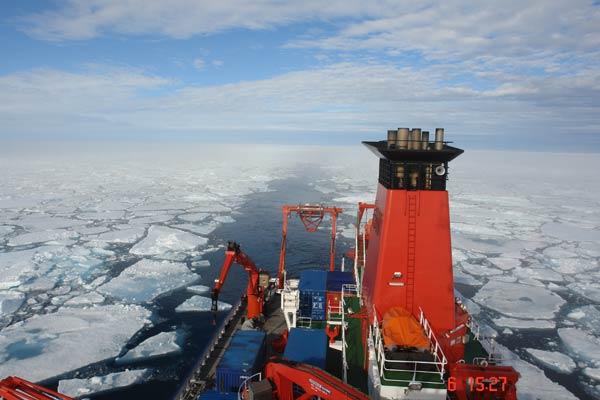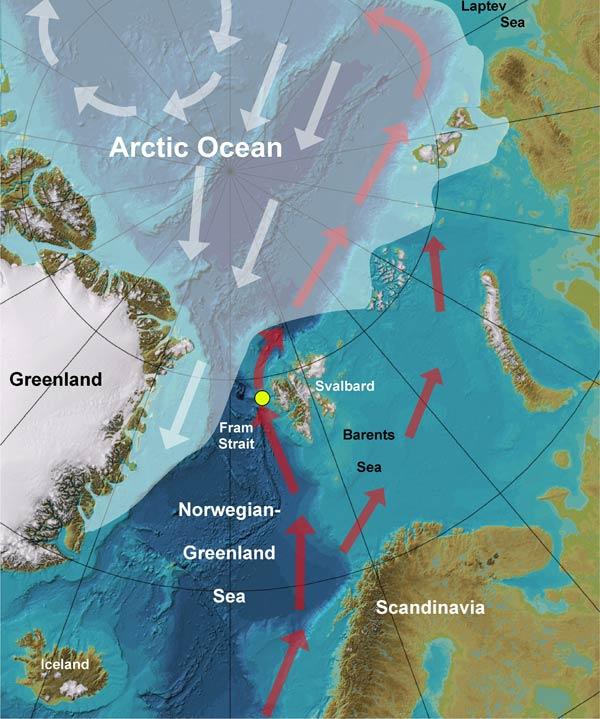Warming Ocean Water Melting Arctic 'Sea Ice Factories'


The effects rising temperatures are having on the Earth's climate are becoming increasingly apparent and nowhere more so than in the Arctic, where substantial sea ice melt and other signs of warming have been observed in recent years.
Researchers now think they've figured out why climate change is having a more pronounced effect in the Arctic region the influx of water from the Atlantic Ocean that feeds into the Arctic Ocean is warmer now than at any time in the 2,000 years prior.
Many residents of the Northern Hemisphere are suffering through an unusually snowy and chilly winter, but while those below the Arctic are shivering in the cold, denizens of the northernmost latitudes have seen very warm winter months in recent years. A climate pattern known as the Arctic Oscillation is playing a part in this temperature flip, scientists suspect, but global warming has also been heating up the Arctic atmosphere and oceans.
Reporting today (Jan. 27) in the journal Science, a group of scientists from the Leibniz Institute of Marine Sciences in Germany evaluated seafloor sediment core containing a record of plankton dating back about 2,000 years. Based on the species present in the sediment and a chemical evaluation of the amount of magnesium and calcium minerals that make up the shells of certain organisms and fluctuate in abundance depending on water temperature scientists were able to determine how water temperature has changed from around 2,000 years ago up through the present.
The core was taken from the Fram Strait, the area where the Atlantic Ocean feeds into the Arctic Ocean between Greenland and the northernmost islands of Norway.
According to the researchers' analyses, throughout history, water temperature fluctuated in the strait by only about 1 degree Fahrenheit (0.5 degrees Celsius), even during the mini-ice age in Europe and the relatively warmer period during the medieval ages, until about 100 to 110 years ago, when the temperature of water entering the Arctic began to spike.
Now, the water is about 3.6 degrees F (2 degrees C) warmer than it was 100 years ago, or has ever been, and is likely contributing to the melting sea ice in Arctic waters , the study suggests.
Get the world’s most fascinating discoveries delivered straight to your inbox.
"Many people are worried about the ice recession in the Arctic," Robert Spielhagen, a paleoceanographer at the Leibniz Institute and lead author of the study, told OurAmazingPlanet.
The decrease in ice cover is usually correlated with warming atmospheric temperatures, which do play a role, but now it also appears that the warmer water entering from the Atlantic is contributing as well, Spielhagen said.
In the Arctic, the sea ice is typically about 2 to 3 meters (6.5 to 10 feet) thick. Then there is a layer of very cold water with a lower salt content that extends about 150 to 200 meters (500 to 650 feet) below the surface. Below that layer is warmer, higher-salt content water, that flows from the Atlantic through the Fram Strait.
As the warmer water from the Fram Strait enters into the Arctic, the heat is transferred upward, melting the ice from below, Spielhagen explained. "Not only has the area of ice coverage been decreasing, but also the thickness of that ice ," he said.
Even more alarming, once the water from the Fram Strait enters the Arctic, it travels along the relatively shallow Canadian and Alaskan continental margins, where the shelves that lead up to the landmasses meet the deep sea. These areas are where the sea ice is formed, so the warmer water circulating through the area could change or even halt sea ice formation.
"It's sort of like a sea ice factory," Spielhagen said. "The water freezes on those shelves in the winter, and then is driven by winds into the central Arctic."
Already, the water is freezing later in the year, and the ice is breaking up earlier. "At some point, this sea ice factory will not work in the same way or with the same efficiency as it's been working for hundreds of thousands of years," Spielhagen said.
- Earth in the Balance: 7 Crucial Tipping Points
- Inuit Dog Sleds Help Measure Arctic Sea Ice
- What Is Sea Ice?



